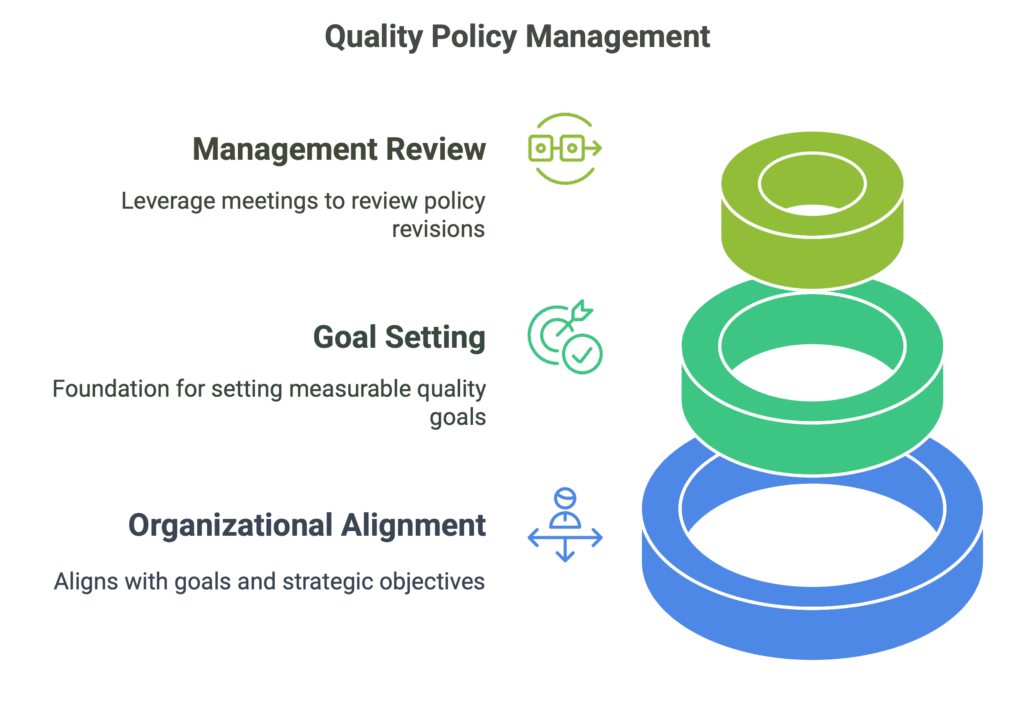The quality policy is outlined in the ISO 9001:2015 standard. While the IATF 16949 standard does not include specific requirements for the quality policy, it remains an integral part of the organization’s operation.
Quality policy – what is it?
It can be defined as a set of organizational intentions and directions formally expressed by top management. We should also emphasizing that top management is responsible for implementing and maintaining the quality policy, one of its key roles within the organization. Also, it’s crucial to bear in mind that the policy should be suitable for:
- goals,
- context,
- organizational strategy.
Thus, it refers to the requirements of the fourth chapter of the ISO 9001 standard. Additionally, this document provides a framework for establishing quality goals. Therefore, it is a commitment to meeting the requirements of both customers and legal and regulatory standards.
Quality Policy in the context of communication
The ISO 9001 standard also includes a requirement to communicate this policy. Therefore, it should be available as documented information, stored, and actively communicated within the organization. Additionally, interested parties, such as the certification body, can request access to it, enabling them to review it prior to the audit.
Let’s also remember to provide easy access to the policy document and promote awareness among employees about its meaning and goals. This can be achieved through:
- periodic refresher training (including e-learning),
- email campaigns addressed to employees,
- communication meetings (including remote sessions),
- initial training during onboarding
How to audit the Quality Policy?
During system audits, it is beneficial to assess the understanding of this document among process owners by inquiring about its content. This doesn’t imply that they need to recite it from memory. Why? Because the implementation of the quality policy may vary between management and operational employees.
As internal system auditors, it is also valuable to demonstrate empathy. If you receive insufficient information, seize the opportunity to provide basic information about this document during the audit.
Best Practices in Quality Policy Management
Effective management of this document is a crucial component of a robust quality management system in any organization. So, what should you keep in mind?

Focus on the Organization’s Goals and Strategy
Ensure that it is aligned with the organization’s goals and strategy. The optimal approach stems from a thorough understanding of the organization’s context, business objectives, and development strategies. Management should actively participate in determining how the policy aligns with and supports the organization’s strategic goals.
Policy-Driven Goal Setting
This document serves as a foundation for establishing quality goals. Companies that excel in quality management set measurable and achievable goals that align with policy commitments. This fosters continuous improvement and the effective implementation of quality policy principles.
Use Management Review
While there is no explicit requirement in the ISO 9001 and IATF regarding the review of policies during a management review, it is beneficial to leverage this meeting for presenting current revisions of policies used in the company.
In addition to this policy, you can present other policies such as the Environment Health and Safety Policy, Information Security Policy, and more.
Summary
Effective quality policy management necessitates a close connection with the organization’s goals, the establishment of measurable quality objectives, and active communication and employee involvement. Companies that adopt these practices lay solid foundations for achieving excellence in quality management.
Dariusz Kowalczyk


